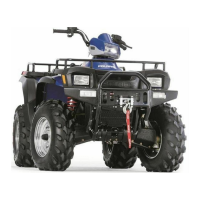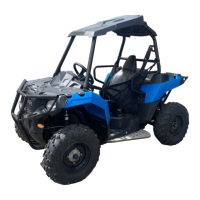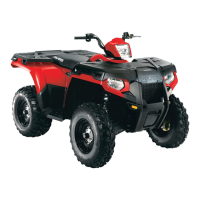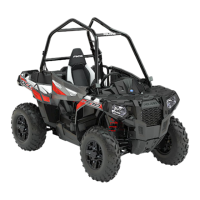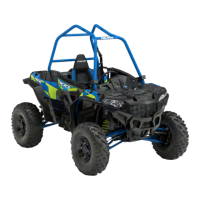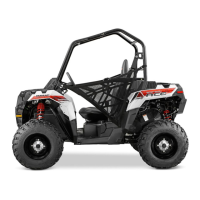BRAKES
9.3
HYDRAULIC BRAKE SYSTEM OPERATION
A
B
C
D
E
F
Must be clear to allow
proper diaphragm
movement
Compensating port compensates
for temperature changes by allowing
fluid back to master cylinder
Moveable
Brake Pad
G
Typical Hydraulic Brake System
The Polaris brake system consists of the following components or assemblies: brake lever; master cylinder;
hydraulic hose; brake calipers (slave cylinder); brake pads; and brake discs, which are secured to the drive line.
When the hand activated brake lever (A) is applied it contacts a piston (B) within the master cylinder. As the
master cylinder piston moves inward it closes a small opening (compensating port) (C) within the cylinder and
starts to build pressure within the brake system. As the pressure within the system is increased, the piston (D)
located in the brake caliper moves outward and applies pressure to the moveable brake pad. This pad contacts
the brake disc and moves the caliper in its floating bracket, pulling the stationary side pad into the brake disc.
Theresultingfrictionreduces brakediscandvehiclespeed. As the leverpressureis increased,the brakingaffect
is also increased.
Thefrictionappliedtothebrakepadswillcausethepadstowear. Asthesepads wear,thepistonwithin thecaliper
moves furtheroutwardandbecomes self adjusting. Fluidfrom thereservoir fills the additionalarea createdwhen
the caliper piston moves outward.
Brake fluid level is critical to proper system operation. Too little fluid will allow air to enter the system and cause
the brakes to feel spongy. Too much fluid could cause brakes to drag due to fluid expansion.
Locatedwithinthemastercylinderisthecompensatingport(C)whichisopenedandclosedbythemastercylinder
piston assembly. The port is open when the lever is released and the master cylinder piston is outward. As the
temperature within the hydraulic system changes, this port compensates for fluid expansion (heated fluid) or
contraction(cooledfluid). Duringsystemservice, besurethisport isopen. Duetothehigh temperaturescreated
withinthesystemduringheavybraking,itisveryimportantthatthemastercylinderreservoirhaveadequatespace
toallowforfluidexpansion. Never overfill thereservoir! Fillto1/4″ -5/16″ (.64-.80cm)from topof thecylinder.
This system also incorporates a diaphragm (E) as part of the cover gasket; and a vent port (F) located between
the gasket and the cover. The combination diaphragm and vent allow for the air above the fluid to equalize
pressure as the fluid expands or contracts. Make sure the vent is open and allowed to function. If the reservoir
is over filledor the diaphragm vent is plugged theexpanding fluid maybuild pressure in thebrake systemleading
to brake failure.
WhenservicingPolarisATVbrakesystemsuseonlyPolarisDOT3HighTemperatureBrakeFluid(PN2870990).
W ARNING: Once a bottle is opened, use what is necessary and discard the rest in accordance with local laws.
Do not storeor use a partialbottleof brakefluid. Brakefluid is hygroscopic, meaning it rapidly absorbsmoisture.
Thiscausestheboilingtemperatureofthebrakefluidtodrop,whichcanleadtoearlybrakefadeandthepossibility
of serious injury.
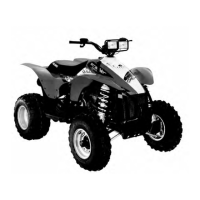
